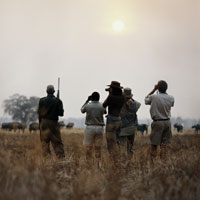The African continent comes in many shades and textures, but few feel more authentic than those boasted by the richly diverse Zambian landscape. Nomadic tribes have wandered its landlocked plains for millennia, but only since the 18th century has it really been settled; first by regional tribes migrating from other areas of Africa and then by the English a century later.
The country derives its name from the mighty Zambezi river, a fisherman’s delight home to some of the most prized freshwater species in the world, not to mention the majestic Victoria falls on the border with Zimbabwe – comparable with Niagara and Iguazu and by some measures the largest in the world. But it is on the fertile flood plains to the north and in the South Luangwa National Park that the nation’s real treasures are found; its diverse and wondrous wildlife that includes elephants, hippos, leopards and more species of birds than you could ever hope to see.
Towns and cities are few and far between, though modernisation and urbanisation are already apace in what is a relatively young democracy. This need not spoil anything; the government has long recognised the importance of its breathtaking wilderness areas and over a third of the country is protected as national park. Gemstone mining and hydro-power promise to be cornerstones of a developing economy and, as investment opportunities continue to grow, Zambia is grasping the future with two hands.
Getting there
Most international flights land in Lusaka, though there are a few available to Livingstone, Mfuwe and Ndola. Border crossings to all neighbours except Mozambique are possible by bus; borders are open between 6am and 6pm.
Getting around
Trains are extremely limited and intercity bus travel can be tedious and uncomfortable. Driving is an option; four-wheel drive vehicles should be preferred. Domestic air travel is by far the most convenient and comfortable method of intercity travel.
Local information
Language(s): English; several regional languages are also recognised.
Time: UTC+2
Climate: Tropical monsoon. Hot, wet summers; warm dry winters. Temperature: Max 31°C (October), Min 10°C (July). Rainfall: Max 230mm (December), Min: 0mm (June-August)
Currency: Zambian kwacha (ZMK)
Business etiquette: English is widely used in business meetings. Standards of dress for Zambian businessmen may vary but formal wear is generally expected and suits should be worn to the first meeting at least.
Tipping: Tipping is technically illegal but often expected anyway. 10 percen is a good rule of thumb but its worth checking locally.
Duty free: 400 cigarettes or 500g tobacco; 2.5l beer, wine or spirits.
Safety: Avoid the border areas with Congo and Angola because of landmines.
Laws: Passport and visa should be carried at all times.
Healthcare: Vaccinations required for diphtheria, hepatitis A, malaria, tetanus and typhoid. Boil or sterilise water before drinking. Health insurance is essential and should include emergency evacuation/repatriation; health services in rural areas are largely non-existent.
Socket type: Type C, Type D





